Dialogue tags help readers know which character is speaking.
“We need to talk,” she said.
Rebecca whispered, “Let’s get out of here.”
“Please,” he said, “let me come with you.”
Notice that a comma follows a tag that’s at the beginning or in the middle of a sentence. And a comma precedes a tag that’s in the middle of a sentence or at the end of a sentence.
Also, see how the comma at the end of the dialogue (before the tag) goes inside the quotation marks? And the period at the end of the dialogue goes inside the quotation marks? That’s how it’s done in American English.
When should a dialogue tag be used?
Dialogue tags are used so that readers don’t become confused, but tags aren’t always necessary.
Take a look at the following conversation written by yours truly. (No, I am not as creative as my clients! But I do know grammar, punctuation, and fiction writing conventions!)
“Did you see that?” I asked, turning to Sarah.
“Did I see what?”
“That bright flash!” I turned back to the sky. Nothing.
“I don’t know what you’re talking about,” Sarah said. Her eyes narrowed. “Did you get any sleep last night?”
“I slept a little.” I pushed away from the railing and took Sarah’s hand. “Never mind. Let’s keep going.”
See how I used only two dialogue tags in the above conversation? Sometimes I used action beats to show what a character was feeling or to ground the characters in their setting and their relationship with each other. Other times I chose to let the spoken words stand alone. This is perfectly fine to do when it’s clear who is speaking. Varying your use of dialogue tags, action beats, and stand-alone dialogue keeps your writing interesting.

Which dialogue tags are best to use?
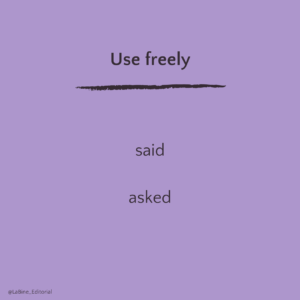 Despite what your middle school English teacher taught you, said and asked are great dialogue tags and can be used freely without worry. Said and asked tend to be invisible to readers. Writers, this is one of the few times repetition in your writing is cool!
Despite what your middle school English teacher taught you, said and asked are great dialogue tags and can be used freely without worry. Said and asked tend to be invisible to readers. Writers, this is one of the few times repetition in your writing is cool!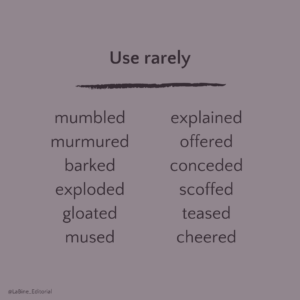
It’s the more unique dialogue tags (e.g., threatened, confirmed, snarled, screeched) that you need to be careful not to repeat often. These tags distract readers; put too many of these wild dialogue tags in your writing and there’s a good chance readers will feel distracted and be unable to get lost in the story.
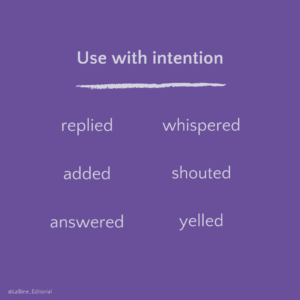 This, of course, is going to depend on your writing style, but my advice is to use said, asked, replied, answered, whispered, shouted/yelled at least 80–90% of the time. Save the unique dialogue tags for special occasions.
This, of course, is going to depend on your writing style, but my advice is to use said, asked, replied, answered, whispered, shouted/yelled at least 80–90% of the time. Save the unique dialogue tags for special occasions.
What about using adverbs with dialogue tags?
Sometimes writers will add an adverb to their dialogue tag to let readers know how the character is speaking or how the character is feeling.
“Well, I don’t think he should be at this party,” Marissa said furiously.
There’s a better way to let readers know that Marissa is furious, and that’s by using an action beat.
Marissa folded her arms over her chest and huffed. “Well, I don’t think he should be at this party.”
This is the ole “show, don’t tell” rule in action.
Action beats are not dialogue tags!
Be careful not to use action beats as dialogue tags. For example:
“Sure!” she laughed.
She shrugged, “Sure.”
Don’t do this! It’s generally accepted that a person can’t really laugh or shrug a “sure.”
Action beats are punctuated differently than dialogue tags. Here’s how to do it instead:
“Sure!” She laughed. OR She laughed. “Sure!” OR “Sure!” she said with a laugh.
AND She shrugged. “Sure.”
Some editors and writers are super strict about this and won’t even allow the following:
“No,” he groaned.
Personally, I like to use a more moderate approach in these situations. I think words can sometimes be groaned and sighed. However, I don’t consider smirked, grinned, or laughed to be acceptable dialogue tags. They’re action beats and need to be punctuated as such.
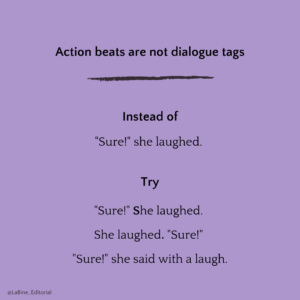
Remember, fiction writing is an art, not a science. Writers are not always going to agree with each other on what is “right” and what is “wrong.” And neither are editors. In this blog post I’m giving you some generally accepted conventions. As the author of your writing, you’ll have to make the final decisions.
Need more help with your dialogue?
My mini-course Character Conversations covers all the above material and more, in video format. Get further explanations from me, along with a checklist to help guide your self-editing. Learn more here!
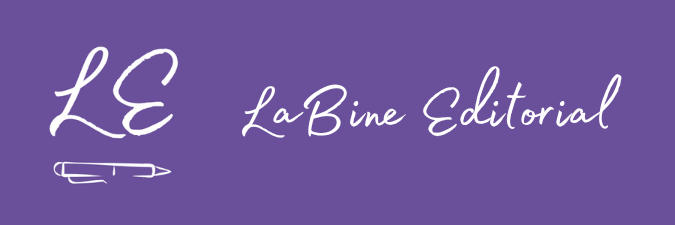
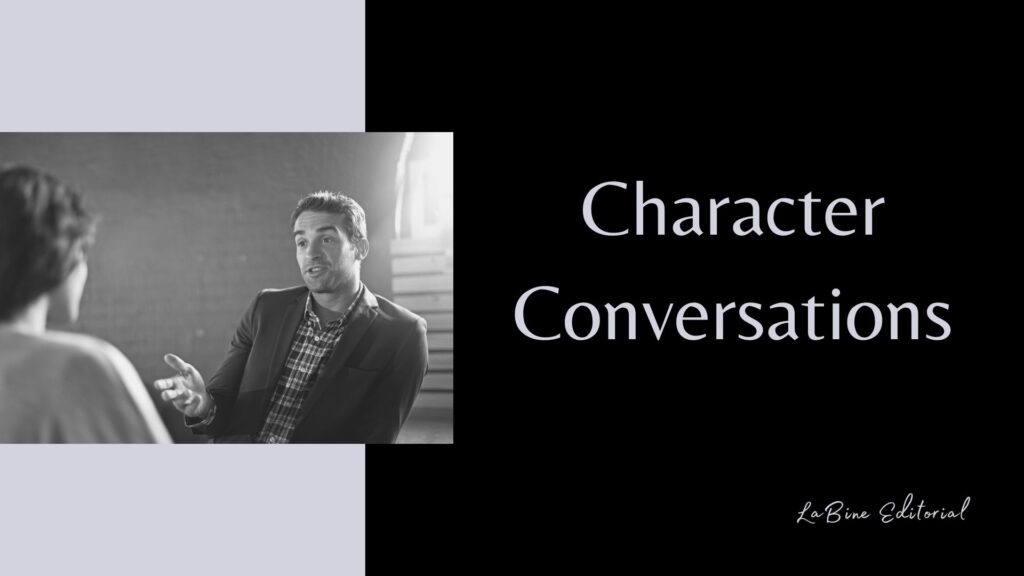
Pingback: Action Beats - LaBine Editorial